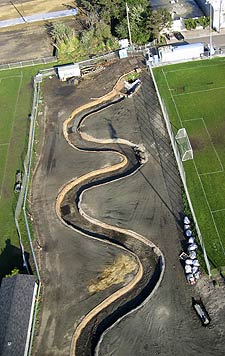Berkeleyan
A tale of two cities, one campus, a handful of hardy native fish, and a struggling urban creek
The adjacent municipalities of Albany and Berkeley are collaborating with UC Berkeley to restore a stretch of Codornices Creek that runs along their border
![]()
| 12 January 2005
 A meandering course changes much about a stream, including its length, its behavior during floods, its suitability for wildlife . . . and its profile from the air. (Charles C. Benton photo) |
The two East Bay cities are working in tandem with UC Berkeley on an ambitious plan to restore a half-mile stretch of Codornices Creek — the section that runs along the south edge of UC’s University Village housing complex, from San Pablo Avenue downstream to the railroad tracks. Phase one, completed in fall 2004, restored the stream from a constricted channel to a meandering profile in order to improve flood control and enhance habitat for native flora and fauna — such as the small but hardy population of steelhead that spawn in the creek’s lower reaches.
All three partners were “at the table” at virtually every stage of the planning, says project manager Ann Chaney, director of community development for the city of Albany. “It has been a hard project because of all the nuances, but a fascinating one. It took everybody’s energy, thinking, and willingness to make this happen.”
The project was funded by a $985,000 grant from the California Department of Water Resources, as well as monies from the California Coastal Conservancy, CalTrans, the Union Pacific Railroad, and Albany’s Measure R, passed by that city’s voters in 1996 to fund open-space projects. The university’s Capital Projects, Residential and Student Service Programs, and Environmental Health and Safety (EH&S) offices have made in-kind contributions — from overseeing soil-characterization work to relocating several University Village buildings to accommodate the stream’s meandering route. The plan calls next for removing culverts and bridge piers, restoring stream banks and native vegetation, and creating a pathway for bicyclists and pedestrians, with footbridges across the stream.
“It’s a project that is going to meet UC goals for clean water and drainage and flood control, and will be a real asset to University Village residents — and to Albany and Berkeley residents,” Chaney says.
The Codornices is one of the most open creeks in the East Bay, “so has a lot of potential to be restored,” notes Steve Maranzana, environmental specialist at EH&S. It is one of only a handful of local streams where native steelhead can still be found and could support far more fish, experts say, if migration barriers are removed and work is done to restore shading vegetation, deep pools, and spawning beds. Restoration of this stretch of Codornices Creek could one day figure into a far more ambitious vision to rehabilitate tidal wetlands and feeder creeks in order to create an Eastshore State Park.
To reach the new meander from city streets, start at the corner of Fifth and Gilman Streets in Berkeley and go north two blocks, to where Fifth dead-ends at Codornices Creek.

